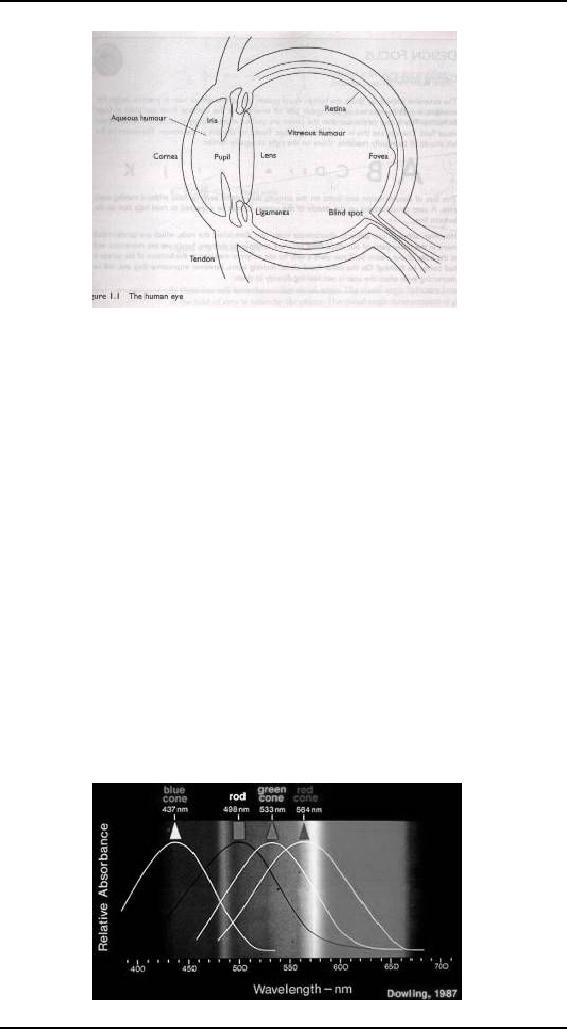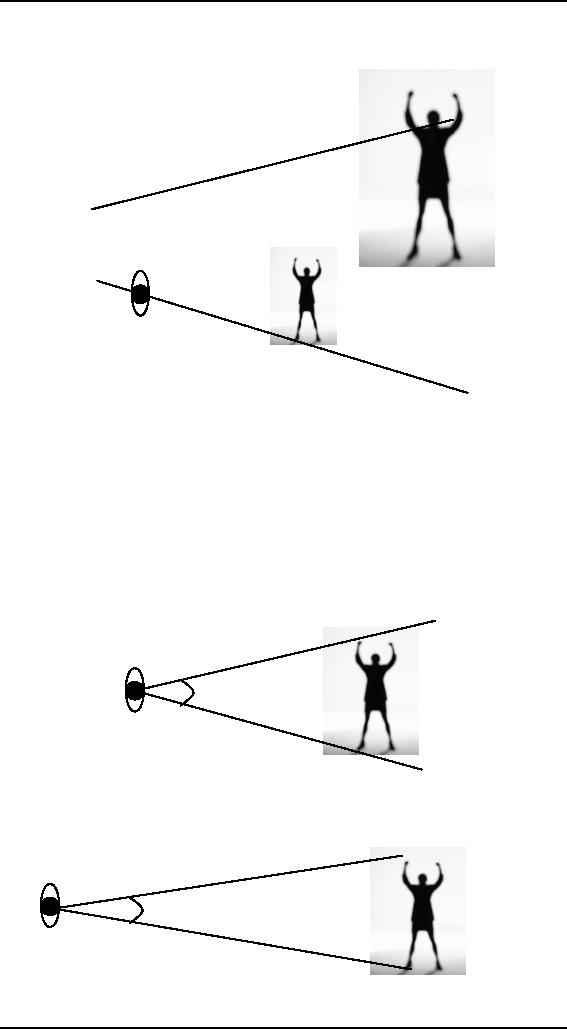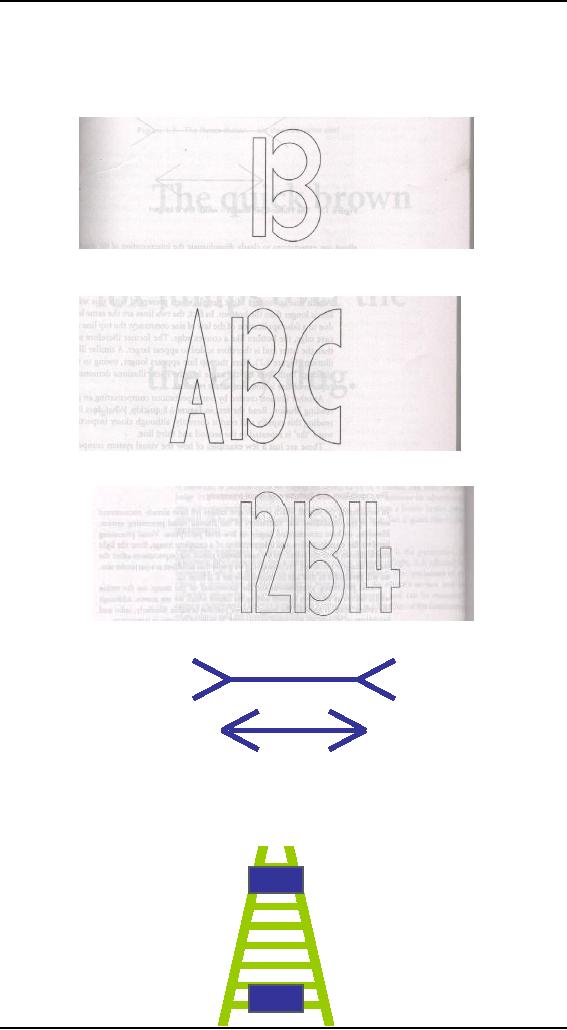 |
HUMAN INPUT-OUTPUT CHANNELS, VISUAL PERCEPTION |
| << COGNITIVE FRAMEWORKS: MODES OF COGNITION, HUMAN PROCESSOR MODEL, GOMS |
| COLOR THEORY, STEREOPSIS, READING, HEARING, TOUCH, MOVEMENT >> |

Human
Computer Interaction
(CS408)
VU
Lecture
7
Lecture 7.
Human
Input-Output Channels
Part I
Learning
Goals
As the
aim of this lecture is to
introduce you the study of
Human Computer
Interaction,
so that after studying this
you will be able to:
Understand
role of input-output channels
�
Describe
human eye physiology
and
�
Discuss
the visual perception
�
7.1
Input
Output channels
A
person's interaction with
the outside world occurs
through information
being
received
and sent: input and output.
In an interaction with a computer
the user
receives
information that is output by
the computer, and responds
by providing input
to the
computer the user's
output become the computer's
input and vice versa.
Consequently
the use of the terms
input and output may
lead to confusion so we
shall
blur
the distinction somewhat and
concentrate on the channels involved.
This blurring
is
appropriate since, although a particular
channel may have a primary
role as input or
output in
the interaction, it is more
than likely that it is also
used in the other role.
For
example,
sight may be used primarily
in receiving information from
the computer, but
it can
also be used to provide information to
the computer, for example by
fixating on
a
particular screen point when
using an eye gaze
system.
Input in
human is mainly though the
senses and out put
through the motor control
of
the
effectors. There are five
major senses:
� Sight
� Hearing
� Touch
� Taste
� Smell
Of these
first three are the most
important to HCI. Taste and
smell do not
currently
play a
significant role in HCI, and
it is not clear whether they
could be exploited at
all
in
general computer systems,
although they could have a
role to play in more
specialized
systems or in augmented reality
systems. However, vision
hearing and
touch
are central.
Similarly
there are a number of
effectors:
� Limbs
54

Human
Computer Interaction
(CS408)
VU
Fingers
�
Eyes
�
Head
�
Vocal
system.
�
In the
interaction with computer,
the fingers play the
primary role, through typing
or
mouse
control, with some use of
voice, and eye, head and
body position.
Imagine
using a personal computer
with a mouse and a keyboard.
The application you
are using
has a graphical interface,
with menus, icons and
windows. In your
interaction
with this system you
receive information primarily by
sight, from what
appears
on the screen. However, you
may also receive information
by ear: for
example,
the computer may `beep' at
you if you make a mistake or
to draw attention
to
something, or there may be a
voice commentary in a multimedia
presentation.
Touch
plays a part too in that
you will feel the keys
moving (also hearing the
`click')
or the
orientation of the mouse, which
provides vital feedback
about what you
have
done.
You yourself send
information to the computer
using your hands either
by
hitting
keys or moving the mouse.
Sight and hearing do not
play a direct role in
sending
information in this example,
although they may be used to
receive
information
from a third source (e.g., a
book or the words of another
person) which is
then
transmitted to the
computer.
7.2
Vision
Human
vision is a highly complex
activity with range of physical
and perceptual
limitations,
yet it is the primary source
of information for the
average person. We can
roughly
divide visual perception
into two stages:
� the
physical reception of the
stimulus from outside world,
and
� the
processing and interpretation of that
stimulus.
On the
one hand the physical
properties of the eye and
the visual system mean
that
there
are certain things that
cannot be seen by the human;
on the other
interpretative
capabilities
of visual processing allow images to be
constructed from
incomplete
information.
We need to understand both stages as
both influence what can
and can
not be
perceived visually by a human
being, which is turn
directly affect the way
that
we design
computer system. We will begin by
looking at the eye as a
physical
receptor,
and then go onto consider
the processing involved in basic
vision.
The human
eye
Vision
begins with light. The
eye is a mechanism for receiving
light and
transforming
it into
electrical energy. Light is
reflected from objects in
the world and their
image is
focused
upside down on the back of
the eye. The receptors in
the eye transform it
into
electrical
signals, which are passed to
brain.
55

Human
Computer Interaction
(CS408)
VU
The
eye has a number of
important components as you
can see in the figure.
Let us
take a
deeper look. The cornea and
lens at the front of eye
focus the light into a
sharp
image on
the back of the eye,
the retina. The retina is
light sensitive and contains
two
types of
photoreceptor: rods and
cones.
Rods
Rods are
highly sensitive to light
and therefore allow us to
see under a low level
of
illumination.
However, they are unable to
resolve fine detail and are
subject to light
saturation.
This is the reason for
the temporary blindness we
get when moving from
a
darkened
room into sunlight: the rods
have been active and are
saturated by the
sudden
light. The cones do not
operate either as they are
suppressed by the rods. We
are
therefore temporarily unable to
see at all. There are
approximately 120
million
rods per
eye, which are mainly
situated towards the edges
of the retina. Rods
therefore
dominate
peripheral vision.
Cones
Cones
are the second type of
receptor in the eye. They
are less sensitive to light
than
the rods
and can therefore tolerate
more light. There are
three types of cone,
each
sensitive
to a different wavelength of light.
This allows color vision.
The eye has
approximately
6 million cones, mainly
concentrated on the
fovea.
56

Human
Computer Interaction
(CS408)
VU
Fovea
Fovea is
a small area of the retina
on which images are fixated.
Blind
spot
Blind
spot is also situated at retina.
Although the retina is
mainly covered with
photoreceptors
there is one blind spot
where the optic nerve
enter the eye. The
blind
spot has
no rods or cones, yet our
visual system compensates
for this so that in
normal
circumstances we
are unaware of it.
Nerve
cells
The
retina also has specialized
nerve cells called ganglion
cells. There are two
types:
X-cells
These are
concentrated in the fovea
and are responsible for
the early detection
of
pattern.
Y-cells
These are
more widely distributed in
the retina and are
responsible for the
early
detection
of movement. The distribution of
these cells means that,
while we may not
be able
to detect changes in pattern in
peripheral vision, we can
perceive movement.
7.3
Visual
perception
Understanding
the basic construction of the
eye goes some way to
explaining the
physical
mechanism of vision but visual
perception is more than
this. The information
received
by the visual apparatus must be filtered
and passed to processing elements
which
allow us to recognize coherent
scenes, disambiguate relative distances
and
differentiate
color. Let us see how we
perceive size and depth,
brightness and color,
each of
which is crucial to the
design of effective visual
interfaces.
Perceiving
size and depth
Imagine
you are standing on a
hilltop. Beside you on the
summit you can see
rocks,
sheep
and a small tree. On the
hillside is a farmhouse with
outbuilding and farm
vehicles.
Someone is on the track, walking
toward the summit. Below in
the valley is
a small
market town.
Even in
describing such a scene the
notions of size and distance
predominate. Our
visual
system is easily able to
interpret the images, which it
receives to take
account
of these
things. We can identify
similar objects regardless of the
fact that they appear
to us to be
vastly different sizes. In
fact, we can use this
information to judge
distance.
So how
does the eye perceive size,
depth and relative
distances? To understand
this
we must
consider how the image
appears on the retina. As we
mentioned, reflected
light
from the object forms an
upside-down image on the
retina. The size of
that
image is
specified as visual angle.
Figure illustrates how the
visual angle is
calculated.
57

Human
Computer Interaction
(CS408)
VU
If were
to draw a line from the
top of the object to a
central point on the front
of the
eye
and a second line from
the bottom of the object to
the same point, the
visual angle
of the
object is the angle between
these two lines. Visual
angle is affected by both
the
size of
the object and its distance
from the eye. Therefore if
two objects are at
the
same
distance, the larger one
will have the larger visual
angle. Similarly, if
two
objects
of the same size are placed
at different distances from
the eye, the furthest
one
will have
the smaller visual angle, as
shown in figure.
58

Human
Computer Interaction
(CS408)
VU
Visual
angle indicates how much of
the field of view is taken
by the object. The
visual
angle measurement is given in either
degrees or minutes of arc, where 1
degree
is
equivalent to 60 minutes of arc, and 1
minute of arc to 60 seconds of
arc.
Visual
acuity
So how
does an object's visual
angle affect our perception
of its size? First, if
the
visual
angle of an object is too
small we will be unable to perceive it at
all. Visual
acuity is
the ability of a person to perceive
fine detail. A number of
measurements
have been
established to test visual
acuity, most of which are included in
standard eye
tests.
For example, a person with
normal vision can detect a
single line if it has
a
visual
angle of 0.5 seconds of arc.
Spaces between lines can be
detected at 30 seconds
to 1
minute of visual arc. These represent the
limits of human visual
perception.
Law of
size constancy
Assuming
that we can perceive the
object, does its visual
angle affect our
perception
of its
size? Given that the
visual angle of an object is
reduced, as it gets further
away,
we might
expect that we would
perceive the object as
smaller. In fact, our
perception
of an
object's size remains constant even if
its visual angel changes. So
a person's
height I
perceived as constant even if they
move further from you.
This is the law of
size
constancy, and it indicated
that our perception of size
relies on factors other
than
the
visual angle.
One of
these factors is our
perception of depth. If we return to
the hilltop scene
there
are a
number of cues, which can
use to determine the
relative positions and
distances
of the
objects, which we see. If
objects overlap, the object
that is partially covered
is
perceived
to be in the background, and
therefore further away.
Similarly, the size
and
height of
the object in our field of
view provides a cue to its
distance. A third cue
is
familiarity:
if we expect an object to be of a certain
size then we can judge
its distance
accordingly.
Perceiving
brightness
A second
step of visual perception is
the perception of brightness.
Brightness is in fact
a
subjective reaction to level of
light. It is affected by luminance,
which is the amount
of light
emitted by an object. The
luminance of an object is dependent on
the amount
of light
falling on the object's surface
and its reflective
prosperities. Contrast is
related
to luminance: it is a function of the
luminance of an object and
the luminance
of its
background.
Although
brightness is a subjective response, it
can be described in terms of
the
amount of
luminance that gives a just
noticeable difference in brightness.
However,
the
visual system itself also
compensates for changes in
brightness. In dim
lighting,
the rods
predominate vision. Since
there are fewer rods on the
fovea, object in low
lighting
can be seen easily when
fixated upon, and are more
visible in peripheral
vision.
In normal lighting, the
cones take over.
Visual
acuity increases with increased
luminance. This may be an
argument for using
high
display luminance. However, as
luminance increases, flicker
also increases. The
eye will
perceive a light switched on
and off rapidly as
constantly on. But if the
speed
59

Human
Computer Interaction
(CS408)
VU
of
switching is less than 50 Hz
then the light is perceived
to flicker. In high
luminance
flicker
can be perceived at over 50
Hz. Flicker is also more
noticeable in peripheral
vision.
This means that the
larger the display, the
more it will appear to flicker.
Perceiving
color
A third
factor that we need to consider is
perception of color. Color is
usually
regarded
as being made up of three
components:
� hue
� intensity
� saturation
Hue
Hue is
determined by the spectral
wavelength of the light.
Blues have short
wavelength,
greens medium and reds
long. Approximately 150
different hues can be
discriminated
by the average person.
Intensity
Intensity
is the brightness of the
color.
Saturation
Saturation
is the amount of whiteness in
the colors.
By
varying these two, we can
perceive in the region of 7
million different
colors.
However,
the number of colors that
can be identified by an individual
without training
is far
fewer.
The
eye perceives color because
the cones are sensitive to
light of different
wavelengths.
There are three different
types of cone, each
sensitive to a different
color
(blue, green and red).
Color vision is best in the
fovea, and worst at
the
periphery
where rods predominate. It should also be
noted that only 3-4 % of
the
fovea is
occupied by cones which are
sensitive to blue light,
making blue acuity
lower.
Finally,
we should remember that around 8% of
males and 1% of females
suffer from
color
blindness, most commonly being
unable to discriminate between
red and green.
The
capabilities and limitations of
visual processing
In
considering the way in which
we perceive images we have already
encountered
some of
the capabilities and
limitations of the human
visual processing system.
However,
we have concentrated largely on
low-level perception. Visual
processing
involves
the transformation and
interpretation of a complete image,
from the light
that
is thrown
onto the retina. As we have
already noted, our
expectations affect the
way
an image
is perceived. For example, if we
know that an object is a
particular size, we
will
perceive it as that size no
matter how far it is from
us.
Visual
processing compensates for the
movement of the image on the
retina which
occurs as
we around and as the object
which we see moves. Although
the retinal
image is
moving, the image that we
perceive is stable. Similarly,
color and brightness
of
objects are perceived as constant, in
spite of changes in
luminance.
This
ability to interpret and
exploit our expectations can
be used to resolve
ambiguity.
For
example consider the image
shown in figure `a'. What do
you perceive? Now
60

Human
Computer Interaction
(CS408)
VU
consider
figure `b' and `c'.
the context in which the
object appears allow
our
expectations
to clearly disambiguate the
interpretation of the object, as
either a B or
13.
Figure
a
However,
it can also create optical
illusions. Consider figure
`d'. Which line is
longer?
concave
Figure
c
convex
the Muller
Lyer illusion
Figure
d
A similar
illusion is the Ponzo illusion as
shown in figure
61
Table of Contents:
- RIDDLES FOR THE INFORMATION AGE, ROLE OF HCI
- DEFINITION OF HCI, REASONS OF NON-BRIGHT ASPECTS, SOFTWARE APARTHEID
- AN INDUSTRY IN DENIAL, SUCCESS CRITERIA IN THE NEW ECONOMY
- GOALS & EVOLUTION OF HUMAN COMPUTER INTERACTION
- DISCIPLINE OF HUMAN COMPUTER INTERACTION
- COGNITIVE FRAMEWORKS: MODES OF COGNITION, HUMAN PROCESSOR MODEL, GOMS
- HUMAN INPUT-OUTPUT CHANNELS, VISUAL PERCEPTION
- COLOR THEORY, STEREOPSIS, READING, HEARING, TOUCH, MOVEMENT
- COGNITIVE PROCESS: ATTENTION, MEMORY, REVISED MEMORY MODEL
- COGNITIVE PROCESSES: LEARNING, READING, SPEAKING, LISTENING, PROBLEM SOLVING, PLANNING, REASONING, DECISION-MAKING
- THE PSYCHOLOGY OF ACTIONS: MENTAL MODEL, ERRORS
- DESIGN PRINCIPLES:
- THE COMPUTER: INPUT DEVICES, TEXT ENTRY DEVICES, POSITIONING, POINTING AND DRAWING
- INTERACTION: THE TERMS OF INTERACTION, DONALD NORMAN’S MODEL
- INTERACTION PARADIGMS: THE WIMP INTERFACES, INTERACTION PARADIGMS
- HCI PROCESS AND MODELS
- HCI PROCESS AND METHODOLOGIES: LIFECYCLE MODELS IN HCI
- GOAL-DIRECTED DESIGN METHODOLOGIES: A PROCESS OVERVIEW, TYPES OF USERS
- USER RESEARCH: TYPES OF QUALITATIVE RESEARCH, ETHNOGRAPHIC INTERVIEWS
- USER-CENTERED APPROACH, ETHNOGRAPHY FRAMEWORK
- USER RESEARCH IN DEPTH
- USER MODELING: PERSONAS, GOALS, CONSTRUCTING PERSONAS
- REQUIREMENTS: NARRATIVE AS A DESIGN TOOL, ENVISIONING SOLUTIONS WITH PERSONA-BASED DESIGN
- FRAMEWORK AND REFINEMENTS: DEFINING THE INTERACTION FRAMEWORK, PROTOTYPING
- DESIGN SYNTHESIS: INTERACTION DESIGN PRINCIPLES, PATTERNS, IMPERATIVES
- BEHAVIOR & FORM: SOFTWARE POSTURE, POSTURES FOR THE DESKTOP
- POSTURES FOR THE WEB, WEB PORTALS, POSTURES FOR OTHER PLATFORMS, FLOW AND TRANSPARENCY, ORCHESTRATION
- BEHAVIOR & FORM: ELIMINATING EXCISE, NAVIGATION AND INFLECTION
- EVALUATION PARADIGMS AND TECHNIQUES
- DECIDE: A FRAMEWORK TO GUIDE EVALUATION
- EVALUATION
- EVALUATION: SCENE FROM A MALL, WEB NAVIGATION
- EVALUATION: TRY THE TRUNK TEST
- EVALUATION – PART VI
- THE RELATIONSHIP BETWEEN EVALUATION AND USABILITY
- BEHAVIOR & FORM: UNDERSTANDING UNDO, TYPES AND VARIANTS, INCREMENTAL AND PROCEDURAL ACTIONS
- UNIFIED DOCUMENT MANAGEMENT, CREATING A MILESTONE COPY OF THE DOCUMENT
- DESIGNING LOOK AND FEEL, PRINCIPLES OF VISUAL INTERFACE DESIGN
- PRINCIPLES OF VISUAL INFORMATION DESIGN, USE OF TEXT AND COLOR IN VISUAL INTERFACES
- OBSERVING USER: WHAT AND WHEN HOW TO OBSERVE, DATA COLLECTION
- ASKING USERS: INTERVIEWS, QUESTIONNAIRES, WALKTHROUGHS
- COMMUNICATING USERS: ELIMINATING ERRORS, POSITIVE FEEDBACK, NOTIFYING AND CONFIRMING
- INFORMATION RETRIEVAL: AUDIBLE FEEDBACK, OTHER COMMUNICATION WITH USERS, IMPROVING DATA RETRIEVAL
- EMERGING PARADIGMS, ACCESSIBILITY
- WEARABLE COMPUTING, TANGIBLE BITS, ATTENTIVE ENVIRONMENTS